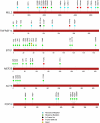Discovery and prioritization of somatic mutations in diffuse large B-cell lymphoma (DLBCL) by whole-exome sequencing
- PMID: 22343534
- PMCID: PMC3309757
- DOI: 10.1073/pnas.1121343109
Discovery and prioritization of somatic mutations in diffuse large B-cell lymphoma (DLBCL) by whole-exome sequencing
Abstract
To gain insight into the genomic basis of diffuse large B-cell lymphoma (DLBCL), we performed massively parallel whole-exome sequencing of 55 primary tumor samples from patients with DLBCL and matched normal tissue. We identified recurrent mutations in genes that are well known to be functionally relevant in DLBCL, including MYD88, CARD11, EZH2, and CREBBP. We also identified somatic mutations in genes for which a functional role in DLBCL has not been previously suspected. These genes include MEF2B, MLL2, BTG1, GNA13, ACTB, P2RY8, PCLO, and TNFRSF14. Further, we show that BCL2 mutations commonly occur in patients with BCL2/IgH rearrangements as a result of somatic hypermutation normally occurring at the IgH locus. The BCL2 point mutations are primarily synonymous, and likely caused by activation-induced cytidine deaminase-mediated somatic hypermutation, as shown by comprehensive analysis of enrichment of mutations in WRCY target motifs. Those nonsynonymous mutations that are observed tend to be found outside of the functionally important BH domains of the protein, suggesting that strong negative selection against BCL2 loss-of-function mutations is at play. Last, by using an algorithm designed to identify likely functionally relevant but infrequent mutations, we identify KRAS, BRAF, and NOTCH1 as likely drivers of DLBCL pathogenesis in some patients. Our data provide an unbiased view of the landscape of mutations in DLBCL, and this in turn may point toward new therapeutic strategies for the disease.
Conflict of interest statement
The authors declare no conflict of interest.
Figures



Similar articles
-
Diffuse large B-cell lymphoma patient-derived xenograft models capture the molecular and biological heterogeneity of the disease.Blood. 2016 May 5;127(18):2203-13. doi: 10.1182/blood-2015-09-672352. Epub 2016 Jan 15. Blood. 2016. PMID: 26773040 Free PMC article.
-
Whole exome sequencing of relapsed/refractory patients expands the repertoire of somatic mutations in diffuse large B-cell lymphoma.Genes Chromosomes Cancer. 2016 Mar;55(3):251-67. doi: 10.1002/gcc.22328. Epub 2015 Nov 26. Genes Chromosomes Cancer. 2016. PMID: 26608593
-
Molecular Pathogenesis of Diffuse Large B-Cell Lymphoma.J Clin Exp Hematop. 2016;56(2):71-78. doi: 10.3960/jslrt.56.71. J Clin Exp Hematop. 2016. PMID: 27980305 Free PMC article. Review.
-
Whole-exome sequencing analysis identifies distinct mutational profile and novel prognostic biomarkers in primary gastrointestinal diffuse large B-cell lymphoma.Exp Hematol Oncol. 2022 Oct 15;11(1):71. doi: 10.1186/s40164-022-00325-7. Exp Hematol Oncol. 2022. PMID: 36243813 Free PMC article.
-
Activating somatic mutations in diffuse large B-cell lymphomas: lessons from next generation sequencing and key elements in the precision medicine era.Leuk Lymphoma. 2015 May;56(5):1213-22. doi: 10.3109/10428194.2014.941836. Epub 2014 Oct 9. Leuk Lymphoma. 2015. PMID: 25130477 Review.
Cited by
-
GPRASP protein deficiency triggers lymphoproliferative disease by affecting B-cell differentiation.Hemasphere. 2024 Oct 30;8(11):e70037. doi: 10.1002/hem3.70037. eCollection 2024 Nov. Hemasphere. 2024. PMID: 39479518 Free PMC article.
-
Sensitive detection of somatic point mutations in impure and heterogeneous cancer samples.Nat Biotechnol. 2013 Mar;31(3):213-9. doi: 10.1038/nbt.2514. Epub 2013 Feb 10. Nat Biotechnol. 2013. PMID: 23396013 Free PMC article.
-
Gauging NOTCH1 Activation in Cancer Using Immunohistochemistry.PLoS One. 2013 Jun 18;8(6):e67306. doi: 10.1371/journal.pone.0067306. Print 2013. PLoS One. 2013. PMID: 23825651 Free PMC article.
-
SOCS1 mutation subtypes predict divergent outcomes in diffuse large B-Cell lymphoma (DLBCL) patients.Oncotarget. 2013 Jan;4(1):35-47. doi: 10.18632/oncotarget.774. Oncotarget. 2013. PMID: 23296022 Free PMC article.
-
Single nucleotide variation in the TP53 3' untranslated region in diffuse large B-cell lymphoma treated with rituximab-CHOP: a report from the International DLBCL Rituximab-CHOP Consortium Program.Blood. 2013 May 30;121(22):4529-40. doi: 10.1182/blood-2012-12-471722. Epub 2013 Mar 20. Blood. 2013. PMID: 23515929 Free PMC article.
References
-
- Abramson JS, Shipp MA. Advances in the biology and therapy of diffuse large B-cell lymphoma: moving toward a molecularly targeted approach. Blood. 2005;106:1164–1174. - PubMed
-
- Pfreundschuh M, et al. German High-Grade Non-Hodgkin Lymphoma Study Group (DSHNHL) Six versus eight cycles of bi-weekly CHOP-14 with or without rituximab in elderly patients with aggressive CD20+ B-cell lymphomas: A randomised controlled trial (RICOVER-60) Lancet Oncol. 2008;9:105–116. - PubMed
-
- Glass B, et al. German High-Grade Non-Hodgkin Lymphoma Study Group (DSHNHL) High-dose therapy followed by autologous stem-cell transplantation with and without rituximab for primary treatment of high-risk diffuse large B-cell lymphoma. Ann Oncol. 2010;21:2255–2261. - PubMed
-
- Alizadeh AA, et al. Distinct types of diffuse large B-cell lymphoma identified by gene expression profiling. Nature. 2000;403:503–511. - PubMed
Publication types
MeSH terms
Grants and funding
LinkOut - more resources
Full Text Sources
Other Literature Sources
Molecular Biology Databases
Research Materials
Miscellaneous

